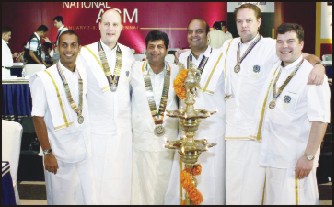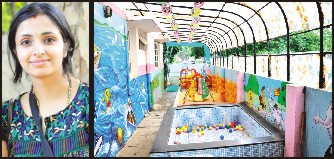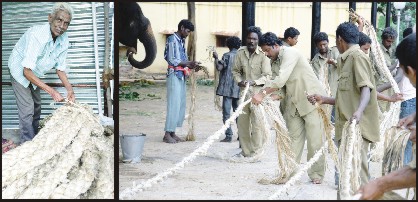
Lakhs of tourists throng the ‘City of Palaces’ to be a part of the world famous Dasara festivities. Among the star attractions is the Mysore Police Band which has been adding flavour to Naada Habba for the past several decades. This weekend’s Star Supplement introduces the Mysore Police Band for those who are newly acquainted with Dasara
An Integral Part of the City’s Culture: 140 years of of Rich Heritage
by S. Kenneth Shishir
The famous Police Band of Mysore, once an integral part of the Maharaja’s court, has been giving top performances, particularly during the famous Dasara festivities.
Band culture is an integral part of the culture of Mysore. Dating back to 1868, Sri Chamarajendra Wadiyar along with his Dewans formed ‘The Palace Bands’ namely the English Band (playing Western music) and the ‘Karnatak Orchestra’ (playing Karnatak classical music) to cater to the official needs of having ceremonials.
Later, the groups were divided into Karnatak music group and English Band. Then they were rechristened as: ‘Karnataka Government Band’ (English Band) and ‘Karnataka Government Orchestra’ (Karnatak troupe).
This 140 year old heritage is a rich legacy connected to the Mysore Palace. Being great patrons and versatile musicians themselves, Sri Chamarajendra Wadiyar followed by Krishna Raja Wadiyar and Sri Jayachamarajendra Wadiyar encouraged the band and orchestra in a great way. The successive rulers were broad minded enough to integrate this art into the social and cultural fabric of the former Mysore State.
The band was formed under the great patronage of Sri Krishnaraja Wadiyar Bahadur- IV and was known as the Palace Band. These Palace Bands (Indian Orchestra and English Band) were integrated to the Police Department in the year 1951 and were invited to Delhi in the same year for the Republic Day Parade.
The Wadiyars are known for their province- a bastion of music, learning and art. Many members of the Royal Family were themselves well-versed in Karnatak and Western music. As such, they felt the need to establish a regimental Band based on the pattern of the English. During the days of the Maharajas, it was presumably a 150 strong orchestra at par with any symphony orchestra in the world. Many directors and scholars of music such as the renowned Frenchman D’fries, Otto Schmidt of Germany, Dr. Alfred Mistowski from Poland and others were hired to train the local musicians.
The Palace Band underwent a subtle transformation of sorts when it was amalgamated into the Police Band during the 1950s. In 1958, they were brought under the offices of the Mounted Police Company of Karnataka.
The English band has a varied range of musical instruments most of which were procured by the Wadiyars. An array of musical instruments, such as Clarinets, Piccolo, Flute, Oboe, bassoon, Saxophone, Trumpets, French horn, Circle Bass, Tuba, Euphonium, Trombone, Drums, etc.
The Band also boasts of a collection of other instruments such as Piano, Violin, Viola, Cello, Double-Bass, Grecian Harp, Bass-Saxophone, Bass Clarinet, Percussive instruments, etc.
Some rare instruments like Horn Cello, Tubular-Bells, Deagan Organ pipes (Tubular Organ), Accordion, Glockenspiel and Xylophone are also the prized collection.
The band enviably has one of the richest music libraries. It houses printed music of the most exotic styles and genres of innumerable composers arranged for various instruments.
A number of Hindustani and Karnatak ragas that have been transcribed into western notation. The band in view of diversifying from playing only martial music has of recent included instruments like Keyboards, Rhythm Guitar, Bass Guitar and a Drum Kit.
In 1981, Dr.G.V.Rao, the then Director General of Police, was instrumental in combining the Police Bands of all district headquarters to give birth to the first massed band programme in front of the Mysore Palace during the Dasara festivities. With a strength, of some 500 men in spectacular uniforms of various colours, the mass band was the first of its kind in South India, second to the “Beating the Retreat” programme by the armed forces during the Republic Day celebrations in Delhi.
Here the English and Karnatak bands take lead and perform a variety of displays, tunes and drill formations.
‘Abide with Me’ composed by W.H. Monk the favourite hymn of Mahatma Gandhi is played by all the units along with trumpets from a distance, giving it an echoing effect. It is also played with Tubular Bells as a finale at the programme.
The Mysore bands, owing to their reputation and expertise have a training centre of martial music, wherein all District Police Bands come and get trained.
Pieces that the English band plays are compositions like Colonel Bogey, Queens Colours, Where the café lights are gleaming, My regiment, Gladiators farewell, Amparito Roca, Sol a Seville, In a Persian market, Hoch Hiedeksberg!, May Blossom, The Sound of Music, Saare -Jahan se achcha, Sher-e-Jawan, Bharath ke jawan, Vienna waltz, etc.
Alla Figaro, Sealed with a Kiss, El-bimbo, Lambada, Every breath you take, My Way, Congratulations, Beethoven’s fifth and Mozart’s Symphony No.40 are some of the more contemporary adaptations for the concert band done by band Masters Felix M. Joseph, Felician M. Joseph, J.M. Pereira and Arokyaswamy.
Ever since its inception, the Band has been winning awards of the highest order. It was awarded ‘Karnataka Kalashree Puraskar’ by Karnataka Sangeetha Nritya Academy in 2001.
The bands perform during government functions, programmes at Mysore Palace, sports event sorganised by the Police Department, visit of VIPs and VVIPs and any other function, under the directive of the three IGPs in charge. English Band and Karnatak bands perform in city parks and also at KRS during certain occasions.
‘Band House’
In the early 20’s, a separate ‘Band House’ on Mirza Road was constructed to house the band and orchestra. Separate enclosures such as the Instruments’ room, music library and an exclusive concert hall apart from other rooms were part of this magnificent structure. This building is presently used as the office of the Commissioner of Police of Mysore city.
The English Band presently has about 50 musicians while the Karnatak band has about 35 in its fold. The induction of these musicians is based on their musical knowledge and qualifications from reputed universities of music.
Former Band Master Felix speaking to SOM, said that the Band is an integral part of the culture of Mysore from the days of the Maharajas, hence should be preserved for heritage sake and added that musicians from Mysore would love to preserve the rich heritage of Mysore city.
List of Band Masters and Asst. Band Masters till date
J. De’fries, M. Pereira, J.M. Pereira, J. Francis Xavier, Felician Joseph, Felix M. Joseph, Arokyaswamy, M.K.Rajendra and Sudharma.
source: http://www.starofmysore.com / Star of Mysore / Home> Features Articles / by S. Kenneth Shishir / September 15th, 2013





